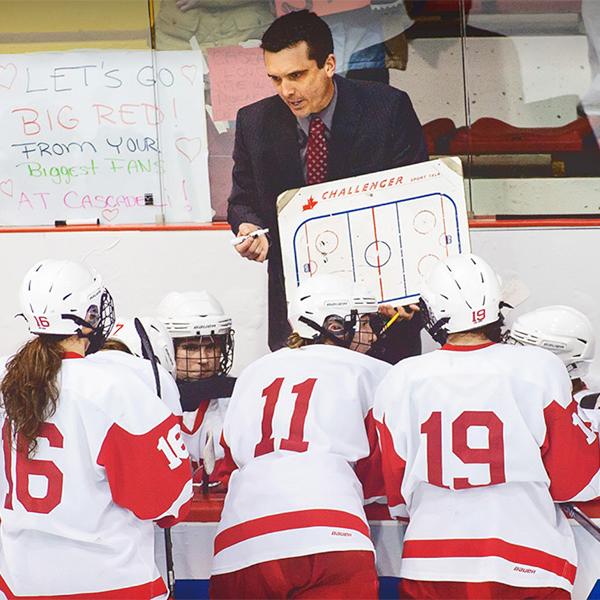LepageFest, a two-day event honoring the career of Peter Lepage, Andrew H. and James S. Tisch Distinguished University Professor Emeritus in the College of Arts and Sciences, was held Oct. 14-15 in the Physical Sciences Building. The conference primarily focused on the current status and future of heavy quark physics while highlighting the science Lepage has done throughout his career.
During that more than 50-year career, Lepage made vital contributions to particle physics, especially quantum chromodynamics (QCD), the theory of quarks and gluons that explains the internal structure and interactions of protons, neutrons and other strongly interacting particles.
“Peter is one of the fathers of lattice QCD, and it is a very vital field today,” said Nigel Lockyer, director of the Cornell Laboratory for Accelerator-based Sciences and Education (CLASSE). (Lattice QCD is an approach to solving the quantum chromodynamics theory of quarks and gluons describing the strong interactions.)
A paper that Lepage co-authored with his graduate advisor Stanley Brodsky, “Exclusive processes in perturbative quantum chromodynamics,” is “sort of the Bible” for QCD, Brodsky said. The paper was so significant that it led in part to both Lepage and Brodsky receiving the Sakurai Prize, the highest prize in particle physics (though in different years).
Another paper by Lepage, co-authored with Brodsky and Paul Mackenzie, M.S. ’78, Ph.D. ’81, Lepage’s first graduate student, “On the elimination of scale ambiguities in perturbative quantum chromodynamics,” is now “used universally to get precision answers in QCD,” said Brodsky.
“In addition to being one of the dominant figures in understanding how QCD describes the strong interactions and how to make sense of this theory, Peter was also one of the very early proponents for the use of effective field theories, a concept that a complicated theory usually gets significantly simpler as you go to lower energies," said Csaba Csaki, John A. Newman Professor of Physical Sciences (A&S) and a LepageFest organizer.
Conference participants included numerous other collaborators and Cornell colleagues, as well as former graduate students, some of whom spoke at an open mic at the opening night banquet.
Many of the speakers praised Lepage’s mentoring; Julia Thom-Levy, professor and chair of physics (A&S), said he always gave “wise and tough advice.”
“Whenever I really need to understand what’s going on, how to understand the system, I come to Peter and just like with physics, after one minute of explanation I understand everything,” said Yuval Grossman, professor of physics (A&S).
Speakers also offered best wishes to Lepage – though, as Matthias Neubert, adjunct professor of physics (A&S) said, “I hope you use your retirement to enjoy music but also to do a little physics, because you’re too good to retire.”
In addition to his prestigious science work, Lepage also made numerous contributions to the College and the university. He served as chair of physics before being appointed dean of the College of Arts and Sciences in March 2004, after serving an eight-month interim term. He stepped down in 2013, making him the second longest-serving dean in College history.
In her introductory comments at the morning session, Rachel Bean, senior associate dean of math and science and the Jacob Gould Schurman Professor of Astronomy (A&S), noted that Lepage oversaw the hiring of approximately one-fourth of the College’s faculty, including herself. She’d been nervous at her interview, she said, “and I remember his kindness.”
Lepage’s legacy as dean also includes two new buildings: the Physical Sciences Building, which includes more than 80 research and teaching laboratories and where LepageFest was held; and Klarman Hall, the first new building for the humanities on central campus since Goldwin Smith Hall opened in 1905.
“But as important as Peter’s faculty hiring initiative was, and as impressive as those two buildings are, it may be his impact on pedagogy at Cornell that has had the furthest-reaching impact,” said Bean. Lepage founded the Active Learning Initiative (ALI), which began as a five-year pilot program in the College of Arts and Sciences and was expanded university-wide because of its success.
“The initiative has impacted numerous courses in 21 departments across the colleges and reaches thousands of students each semester – a transformation of pedagogy at Cornell that began with Peter’s enthusiasm for improving education for our students,” Bean said.
Lepage had the final word at the banquet: “This is a fantastic place to work. I’ve had fantastic collaborations, fantastic colleagues, and I would never trade it for any other possibility. Thank you all,” he said.
Linda B. Glaser is news and media relations manager for the College of Arts and Sciences.




